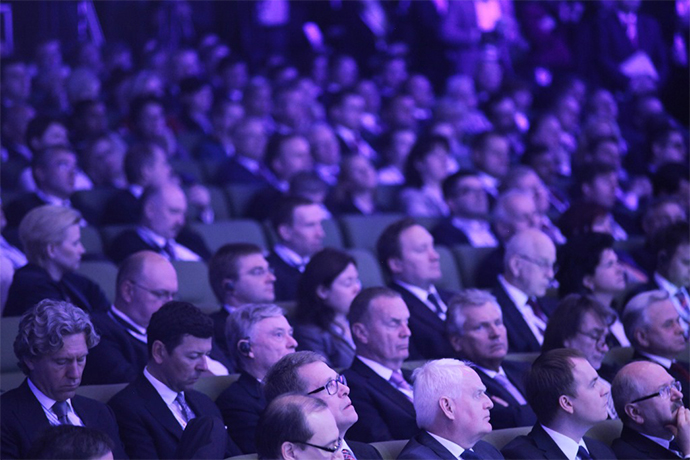The world of corporate multinationals is abuzz this week after the Obama administration strongly urged corporate leaders to stay away from the 18th St. Petersburg International Economic Forum, which says it draws around 5,000 leaders from around the world to discuss Russia’s position and competitiveness in the world economy.
Hosted by President Vladimir Putin, the event, as of early this week, featured executive participants from such companies as Boeing, Danone, Deloitte, BP, Goldman Sachs, AP Moeller-Maersk, Daewoo, GDF Suez, Schlumberger, Deutsche Bank, and DP World, among others. But the US government sees attendance as an endorsement for Putin and therefore for Russia’s widely castigated stance in Ukraine.
The event takes place May 22-24. A presidential election will take place in Ukraine May 25. The White House calls came at an awkward time, precisely as US Commerce Secretary Penny Pritzker, in kicking off World Trade Month May 2, reiterated “the government’s commitment to making international trade an integral part of the DNA of U.S. businesses.” According to data released in February, U.S. exports reached $2.3 trillion in 2013, up nearly $700 billion since 2009. Merchandise exports to the 20 economies that have trade agreements with the United States reached a record $732 billion.
A spokesperson from the US Dept. of Commerce’s International Trade Administration said no official guidance on attendance at the St. Petersburg Forum was available, and referred an inquiry to the White House.
Corporate leaders are caught in the middle. Many executives, including leaders from such companies as Alcoa and Citigroup, already have pulled back from attending. A New York Times report citing a synopsis of an American Chamber of Commerce in Russia meeting included the observation from one executive observer that sudden withdrawals from attendance at the forum will be noted by Putin’s team, “and their Russia business will be impacted.”
However, a May 7 statement from the Russian government sought to reassure those companies by saying withdrawal from the forum will not adversely affect their relations with the Russian government.
“This does not mean that we will close the door to the Russian economy and the Russian market on those companies which will not be coming,” said Sergey Belyakov, deputy minister of economic development of the Russian Federation. “We will, of course, assist them and, unlike the United States, we reject any dialogue that involves putting pressure on business, blatant blackmail, or threats. We can therefore assure these companies that this will have no effect on our relationship with them.”
Belyakov said around 15 percent of company directors originally registered to participate had pulled out. He also said that many companies had explained their decision as motivated by the US’s pressure on them due to the sanctions placed on Russia.
“It is only American companies which are pulling out because of pressure, as they are the ones experiencing it. Their senior executives are forced to bow to this pressure and they themselves see this as unprecedented,” he said.
Also on May 7, President Obama notified Congress that he intends to withdraw Russia’s eligibility for trade benefits under the Generalized System of Preferences (GSP) program “because Russia is sufficiently advanced economically that it no longer warrants preferential treatment reserved for less advanced developing countries, consistent with the requirements of the GSP program.” Once Russia’s eligibility is withdrawn, which would be effected via a presidential proclamation, U.S. imports of GSP-eligible goods from Russia will be subject to normal, non-preferential rates of duty.
| Company | City | Type | N/E | Product | Investment |
|---|---|---|---|---|---|
| Mitsubishi Heavy Industries/PhosAgro/Sojitz | Cherepovets, Moscow | MF | NEW | Ammonia | 785 |
| Bridgestone | Ulyanovsk Oblast | MF | NEW | Tires | 375 |
| Linde Group/JSC Kuibyshev Azot | Togliatti | MF | NEW | Ammonia | 364 |
| Continental | Kaluga | MF | NEW | Tires | 330 |
| Volkswagen | Kaluga | MF | EXP | Automobiles | 314 |
| 3M Company | Alabuga | MF | NEW | Adhesives | 300 |
| Ford Motor Co. | Elabuga | MF | NEW | Automobile Engines | 274 |
| Tonnies Lebensmittel | Voronezh | MF | NEW | Meat Processing | 266 |
| Nissan | Saint Petersburg | MF | NEW | Automobiles | 213 |
| Cargill | Volgograd | MF | NEW | Sunflower Oil | 200 |
| Bombardier | Engels | MF | NEW | Trains | 200 |
| Cadila Pharmaceuticals | Astrakhan | MF | NEW | Pharmaceuticals | 150 |
| Novo Nordisk | Kaluga | MF | NEW | Pharmaceuticals | 100 |
| Mars | Ulyanovsk | MF | NEW | Chocolate | 100 |
| Danieli | Dzerzhinsk | MF | NEW | Machinery | 97 |
| Takeda Pharmaceutical | Yaroslavl | MF | NEW | Pharmaceuticals | 96 |
| Saint-Gobain | Gomzovo | MF | EXP | Glass | 91 |
| Scania | Saint Petersburg | MF | EXP | Trucks | 90 |
| Toyota Motor Corp. | Saint Petersburg | MF | EXP | Auto Parts | 90 |
| Syngenta | Krasnodarskiy Krai | MF | NEW | Seeds | 85 |
| NovaMedica | Kaluga | MF | NEW | Pharmaceuticals | 85 |
“The purpose of the Generalized System of Preferences is to assist developing countries to use trade to boost their economic development,” said US Trade Representative Ambassador Michael Froman. “Russia has advanced beyond the level of economic development and competitiveness for GSP eligibility. As such, Russia should no longer qualify to receive GSP benefits. The President’s decision is consistent with the World Bank’s designation of Russia as a ‘high income country’ as well as actions by the European Union and Canada to remove Russia from similar programs.”
In late 2012, the US Chamber as part of the Coalition for U.S.-Russia Trade sent a letter to Congress signed by more than 500 organizations and companies urging Congress to pass legislation to establish Permanent Normal Trade Relations (PNTR) with Russia. A US Chamber spokesperson said no one was available for comment on the St. Petersburg Forum situation.
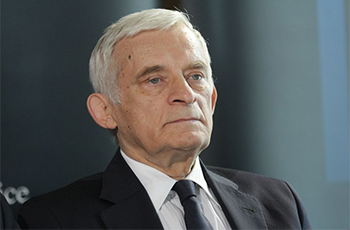
Sergei Millian is president of the Russian-American Chamber of Commerce in the USA, which represents the interests of some 200 small to medium-sized enterprises in accessing the Russia and CIS marketplace. As such, his members are not as likely to get a phone call from the White House.
“But definitely our members are going, and will participate in the forum, because it’s a business forum and not a political forum,” he says, “Companies work with Russia every day, and will plan to continue working with Russia and make money there.”
Millian calls the US government pressure “an exceptional measure from the White House. I don’t remember the last time a measure was used where the White House will call a CEO and ask them not to do something which is really business-related. Politics takes precedence over business in the White House now. It’s definitely a politically motivated decision.”
As for his members, he says, “Mostly they’re curious about what the US will do next.”
This Show Will Go On Too
For corporate leaders eager to access the CIS region, there is a conference alternative. But the party’s already started.
Just to the northwest of Ukraine, below the Baltics and some 900 miles (1,450 km.) southwest of St. Petersburg, around 6,000 corporate, government and community leaders are meeting this week in Katowice, Poland, at the sixth European Economic Congress (EEC), designed around the economic competitiveness of Poland.
At an April press conference in Katowice, Jerzy Buzek, member of the European Parliament, former prime minister of the Republic of Poland and president of the European Parliament, as well as chairman of the EEC Council, said the energy industry will be the leading subject matter of the Congress, just as it has been in the past. According to Buzek, inexpensive and safe energy remains an issue of crucial importance, said an EEC release, as without it, there will be no reindustrialization of Upper Silesia, Poland and Europe. A pending free trade agreement between the EU and the United States is also on the top of the agenda. The emergence of a common market with the potential created by 800 million inhabitants may generate benefits for each party of the agreement in the amount of about €500 billion ($693 billion), Buzek indicated.
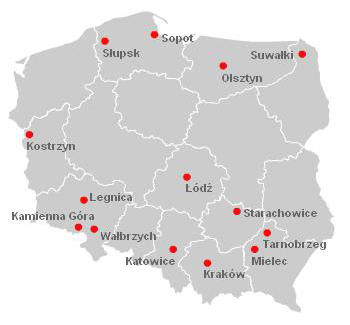
Since January 2012, Site Selection’s New Plant Database has tracked 57 qualifying private-sector facility location or expansion investments in Russia, where the population is just over 143 million, and a healthy 41 projects in Poland, where the population is just over one-fourth the size of Russia’s. As noted in the March 2014 issue of Site Selection by Denis Merkwirth, senior manager – foreign direct investment for Berlin-based global FDI consulting firm Terrain, employment in the services outsourcing sector has been steadily growing in Poland at around 20 percent per year since 2008, according to analysis by Jones Lang LaSalle.
“Poland, with a population of over 38 million (the largest in CEE), now hosts 110,000 of the approximately 300,000 outsourcing jobs in the region,” wrote Merkwirth. “In addition to a large and highly educated workforce, the country also offers a high number of second- and third-tier cities, which are increasingly chosen by investors fearing that established CEE locations such as Prague or Budapest are becoming overcrowded.” New projects have come from Bayer in Gdansk and Genpact in Szczecin. And higher-value-added software development centers have come from the UK’s Lhasa in Poznan and Russia’s Luxoft in Wroclaw.
In the latest survey of the global top 100 destinations for outsourcing investment carried out by the consultancy Tholons, wrote Merkwirth, “Poland’s second-largest city Krakow overtook Dublin as the ninth most attractive destination worldwide. Among the 11 CEE cities included in the ranking, top improvers also included Poland’s capital Warsaw and Wroclaw.”
One Company, 6,000 jobs
But manufacturing and logistics continue to lead the way. Site Selection picked Amazon’s double investment in Poland among the Top Deals of 2013. In order to meet growing customer demand across all of Europe, Amazon in October announced plans to open two new fulfillment centers in Poland by August 2014, and another one in mid-2015. Amazon plans to create up to 2,000 long-term jobs at each, plus an additional 3,000 seasonal jobs at each. The Polish Information and Foreign Investment Agency helped bring the projects across the finish line.
“The establishment of three large fulfillment centers and the creation of thousands of jobs is no doubt a milestone for our further economic growth,” said Poland’s Minister of Economy Janusz Piechociński.
“We appreciate the state and local leaders who have helped us make these sites a reality in such an expeditious way,” said Tim Collins, director of European Operations at Amazon, who told Financial Times that EU-supported highway infrastructure improvements in central and Eastern Europe were key to the company’s location decisions in Poland and in the Czech Republic, where the company is building another two centers.
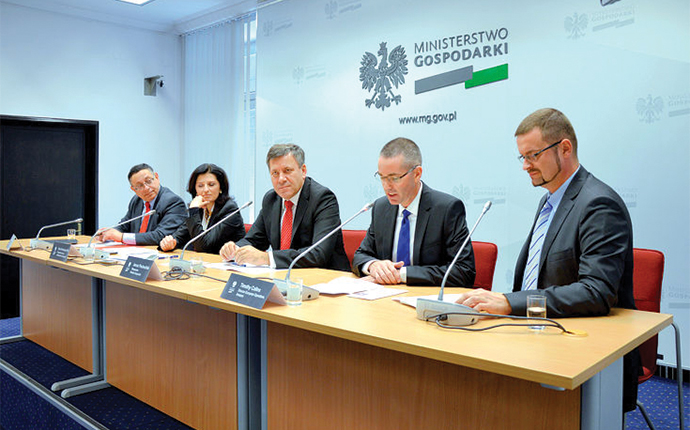
Poland’s central location in Europe and a close connection to key markets were key reasons behind this decision, in addition to access to an employment base. One of the centers opening in 2014 will be located close to Wrocław in Bielany Wrocławskie, in the municipality of Kobierzyce, and leased from Goodman. The second one will be established in Sady close to the city of Poznań, in the municipality of Tarnowo Podgorne, and will be leased from Panattoni Europe. In 2015, a third center will be in Bielany Wrocławskie, near the first Amazon center, and will be leased from Panattoni as well. Each of the new fulfillment centers will have a footprint of 95,000 sq. m. (1 million sq. ft.).
While US corporate FDI in Poland continues to grow, the leading source is Germany, whose MTU Aero Engines, based in Munich, just last month celebrated the five-year anniversary of its engine production facility in Rzeszów in Poland’s “Aviation Valley.” The operation, which focuses on engineering and parts manufacturing, module assembly and parts repair, started in 2009 with 200 employees, has now grown to 500, and is due to grow by another 250 jobs by 2020 thanks to recently announced expansion plans.
| Company | City | Type | N/E | Product | Investment |
|---|---|---|---|---|---|
| BASF | Sroda Slaska | MF | NEW | Plastic Resins | 192 |
| Bridgestone Corp. | Stargard | MF | EXP | Tires | 147 |
| Tognum | Stargard Szczecinski | MF | NEW | Engines | 118 |
| Solvay | Wloclawek | MF | NEW | Silica | 100 |
| Air Liquide | Glogow | MF | NEW | Chemicals | 90 |
| Fagor/Haier Electronics | Wroclaw | MF | NEW | Refrigerators | 76 |
| Metsa Tissue | Krapkowice | MF | NEW | Paper Mill | 75 |
| Carlsberg | Sierpc | MF | NEW | Kasztelan Brewery | 57 |
| MTU Aero Engines | Jasionka | MF | EXP | Aircraft Engines | 53 |
| Sempertrans/Semperit Group | Belchatow | MF | EXP | Fabricated Rubber | 52 |
| DPD/La Poste | Strykow | DW | NEW | Package Delivery | 41 |
| Brembo SpA | Niepolomice | MF | NEW | Automobile Brakes | 37 |
| Automotive Lighting | Sosnowiec | MF | EXP | Lighting | 34 |
| Dr Schneider Kunststoffwerke GmbH | Radomierz | MF | EXP | Plastics | 25 |
| Cargotec | Stargard Szczecinski | MF | EXP | Plumbing Fixtures | 25 |
| Hutchinson/Total SA | Lodz | MF | EXP | Rubber Products | 23 |
This chart of selected projects tracked by Site Selection in Poland since January 2012 shows that while services are coming along in terms of job creation, manufacturing continues to rule the roost when it comes to capex.
“The business volume at our location in the Polish Aviation Valley exceeded our expectations,” said MTU COO Dr. Rainer Martens. “The facility plays an important role in our sourcing strategy regarding our established engine components with a higher labor-intensive work share. Therefore we will expand our activities on-site to support our current ramp-up activities. Further we will expand the R&D department and recruit, for example, about 40 additional development engineers.”
With a €40-million (US$55-million) investment, MTU Aero Engines Polska will add a new, 9,200-sq.-m. (99,000-sq.-ft.) building, which will increase the area occupied by buildings by 50 percent. Rzeszów also just welcomed a new investment from automotive parts manufacturer BorgWarner.
FDI: Origins and Destinations
According to the Polish Information and Foreign Investment Agency, as of 2011, 1,470 companies from 54 countries comprised the list of major foreign investors in Poland, controlling 2,318 corporations in the country. Nearly 50 percent of the 1,566,500 people they employed worked in manufacturing, with 24 percent in trade and repairs. The biggest numbers of foreign investors came from Germany (332 companies), the United States (164) and the Netherlands (129).
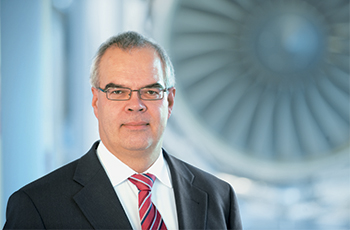
An updated list released by the agency in March takes the total number of major foreign investor companies up by 83 firms to 1,553, from 47 countries. Still leading the way are Germany (348 companies), the United States (174) and the Netherlands (134), followed by France (131), Italy (80) and Sweden (72).
According to figures released by UNCTAD in January, FDI inflows to Russia in 2013 zoomed upward by 83 percent year-over-year to $94 billion, vaulting the country to third worldwide in FDI inflow in 2013, behind the United States ($159 billion) and China ($127 billion). The rise was predominantly ascribed to the large acquisition by BP of a stake in Russia’s Rosneft as part of Rosneft’s US$57-billion acquisition of TNK-BP, which is owned by a company registered in the British Virgin Islands. That said, however, “FDI in the Russian Federation is expected to keep pace with its 2013 performance,” said UNCTAD, “as the Russian Government’s Direct Investment Fund — a US$10 billion fund to promote FDI in the country — has been very actively deployed in collaboration with foreign partners, for example funding a deal with Abu Dhabi’s Finance Department to invest up to US$5 billion in Russian infrastructure.”
Inward FDI to Russia totaled more than $382 billion over the 10 years ending with 2012, when the tally came to a mere $50.6 billion for the year. An UNCTAD Global Investment Trends Monitor update April 28 said Russia also was fourth in the world in 2013 in outward FDI, at $95 billion, just behind China.
A major tool in both Poland and Russia is the deployment of special economic zones. The Polish network consists of 14 zones. According to 2012 analysis by KPMG, 188 business permits were issued across all zones in 2011, a 6-percent increase over 2010 and a 7-percent increase in total jobs, to more than 241,000. The largest number of new permits (22) was issued in Kostrzyńsko-Słubicka SEZ and Łódzka SEZ. The SEZ in the Katowice region led all zones in total capital investment and total employment in 2011, and was expected to do the same in 2012. At the end of 2012, 247,500 people worked in 1,544 companies in Polish SEZs.
Russia boasts 31 SEZs of various types. And the Federation is working hard to cement further investments in its zones from many sources besides the United States.
Earlier this spring, Russia’s Minister of Economic Development Alexey Ulyukaev paid a visit to South Korea, whose companies invested nearly $2 billion in Russia during the first nine months of 2013. In addition to Hyundai Kia’s $600-million plant near St. Petersburg, other investments are coming from LG Electronics, Lotte, Daewoo, and Orion.
“There is considerable potential for developing our investment partnership through collaboration in the fuel and energy sector, shipbuilding, and infrastructure projects in Russia and Korea,” said Ulyukaev in March. “In Russia, we are creating good conditions for all investors, and particularly for our South Korean partners, by lowering administrative barriers, making it easier to connect to utility networks, and creating the best financial condition,” including more zones in Russia’s Far East.
With trade totaling more than $25 billion, South Korea is Russia’s fourth largest trading partner in Asia after China, Japan, and Turkey. In 2012, Russia’s Ministry of Economic Development and the Trade Representation supported four Russian trade missions to Korea. Thirteen such missions took place in 2013, in addition to trade missions from seven Russian regions.
In concluding his March remarks, Ulyukaev said the St Petersburg International Economic Forum would serve as “an excellent forum for consolidating ties between Korean and Russian business leaders.”
